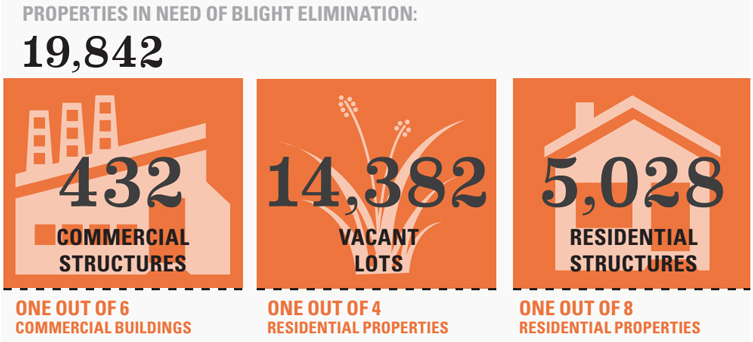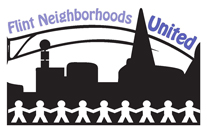City of Flint Adopts Beyond Blight Comprehensive Blight Elimination Framework, Offering a Model for Other Cities
Flint, Michigan – March 12, 2015 – The City of Flint Planning Commission formally adopted Beyond Blight: City of Flint Blight Elimination Framework at its February meeting. With a five-year implementation timeline, the Framework uses a data-driven approach that brings increased transparency and clarity to the scale of the challenge in Flint and efforts currently underway. Supporters describe it as heralding a new era in the City’s approach to problem properties.
“Flint is a city in transition and we have been struggling with blight for many years, but now we have a plan to eradicate blight in every neighborhood,” said Mayor Dayne Walling. “By being strategic with all of our collective resources, we are going to win the war against blight.” 19,842 properties in Flint are in need of blight elimination, including commercial buildings, residential structures, and vacant lots, representing more than one-third of all properties in the city.
“For the first time, we have the real and complete numbers: the scale and cost of the problem, the value of the work already being done, and the resources that we need to secure,” said Megan Hunter, director of planning and development for the City of Flint.
With this information, it is possible to move forward strategically and effectively. The Framework calculates, for the first time, the total cost of removing blight: $107,748,130 over five years. This factors in demolition (66% of total cost), mowing (28%), waste removal (5%) and boarding (1%).
The Framework also calculates the current funding shortfall at $98,255,850, more than two-thirds of which (69%) is attributed to privately owned property. Thus, the Framework recommends rethinking and rebuilding local systems related to property maintenance standards, including code enforcement.
It also proposes additional options for filling the funding gap, including maintenance innovations to reduce mowing needs and exploring partnerships with anchor institutions and businesses.
Five-year benchmarks in the Framework further quantify what is necessary to eliminate blight in Flint:
- Remove 71,000 tons of garbage
- Board 5,000 vacant structures
- Demolish 5,500 vacant and blighted structures
- Mow 19,842 properties annually
- Reuse 5,000 vacant lots
- Bring 95% of properties into compliance with local ordinances
- Structurally and functionally rehabilitate 850 houses
- Increase commercial building occupancy by 15%
The City of Flint and the Genesee County Land Bank Authority are already taking steps to implement the Framework’s recommendations, such as planting clover on 1,200 vacant lots to reduce mowing needs, increasing the number of community groups engaged in creative board-ups, and aligning federal CDBG funds with Framework’s priorities to support neighborhood improvement projects. The creation the Framework itself implements one of the key objectives of Imagine Flint: Master Plan for a Sustainable Flint, which was adopted in 2013 and is the City’s first master plan in over 50 years.
“The Blight Elimination Framework follows on the heels of the Imagine Flint Master Plan, recipient of the Michigan Association of Planning Excellence in Community Engagement Award,” said Mark Linton, executive director of the White House Council on Strong Cities, Strong Communities. “This Framework has been commended for its thoughtful use of data and new strategies for blight elimination. As the federal government continues to work with the City of Flint through the Strong Cities, Strong Communities initiative (SC2), the Blight Elimination Framework provides a road map that helps us all work together towards a common goal.”
The Framework reflects a community-oriented focus. The City and the Genesee County Land Bank Authority held sixteen engagement sessions, including workshops in each of the city’s wards and workshops with community-based organizations, business leaders, and others, to share and solicit feedback on the Framework.
It also recognizes the value and scale of volunteer efforts in addition to city-led efforts, calculating that residents, community groups, and the local government partnered in neighborhood cleanups, mowing, and boarding valued at $5.6 million in 2013.
“In Flint, community groups and neighbors come together to play a major role in eliminating blight from our neighborhoods, and this Framework quantifies that for the first time,” said Clarence Campbell, vice president of Flint Neighborhoods United (FNU), an organization that represents neighborhood associations and block clubs. “The level of volunteerism and the love that we as a community have for our city is what I believe to be critical to moving Flint beyond blight.”
The Framework builds on existing efforts. Over the past seven years, the City of Flint and the Genesee County Land Bank Authority have invested more than $60 million in blight elimination. The Framework demonstrates the need to double that investment and provides a clear path for strategic resource allocation that improves efficiency.
Other cities have already expressed an interest in learning more about the data-based approach in Beyond Blight: City of Flint Blight Elimination Framework to inform their own blight elimination planning efforts. It will be showcased in a training session at the Center for Community Progress’ national Reclaiming Vacant Properties Conference, to be held in Detroit on May 19-21, 2015.
The City of Flint, Genesee County Land Bank Authority, Center for Community Progress, and Flint Area Reinvestment Office partnered to guide the development of the Framework, which was produced by Natalie Pruett.





